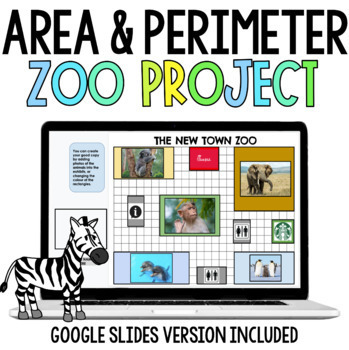Project Based Learning Math Area & Perimeter Zoo Assignment | Print and Digital
- PDF
- Google Apps™

What educators are saying
Description
If you are tired of assigning final unit tests in math, this Area and Perimeter project is perfect for you! This no-prep, project-based learning task will require students to use their math and critical thinking skills to create an Area and Perimeter Zoo. Students will select animals they want, consider spacing (area) requirements, create spaces that are suitable for each exhibit and calculate the area and perimeter of each space. They will also create an advertisement for their zoo when it is complete.
UPDATE: Now available for Google Slides so you can post it to your Google Classroom for differentiation or digital learning.
What's Included?
- Project Outline with requirements
- Project Outline with blank space in requirements (if you'd like to write your own in)
- Size Guidelines (a page that tells students the minimum area required for each type of animal - this is optional)
- Planning Pages
- Planning Grids (to draw the zoo out)
- Construction Phase (for calculating area and perimeter)
- Good Copy Grid Paper
- Advertisement Assignment (2 versions, 1 filled in and 1 blank)
- Self Assessment Rubric
- Rubric with no self-assessment
This is printable and digital for Google Slides. The Google Slides version includes a video tutorial you can share with your students.
Feel free to check the tutorial out here to get a look at the project, digitally:
https://youtu.be/8gw5r1PBjZU
OTHER TEACHERS ARE SAYING...
⭐️⭐️⭐️⭐️⭐️ "My Grade 3's loved doing this project at the end of our Area & Perimeter unit during Distance Learning. They had a lot of fun creating their own zoos and enjoyed the chance to use their imaginations. A lot of the students wanted to share their work with their peers and enjoyed the Media Literacy connections (making a poster). I really appreciate the tutorial for this project, it was very helpful! Thanks!"
⭐️⭐️⭐️⭐️⭐️ We used this to wrap up our area unit. The kids loved taking what they learned about area and applying it to a project. I loved that I could differentiate and use paper copies for some kids and digital for other kids. It was awesome having access to both forms.
_________________________________________________________________
Want to SAVE MONEY on TPT? Consider leaving feedback! For every review you leave, you earn points that you can put towards future purchases. Simply go to "My Purchases" to leave a review on products you have purchased.
Follow Me to receive updates on new products. All of my products are on always on a significant sale for the first 24 hours.
Let's Be Friends! Check out my blog for tips and a free resource library!





